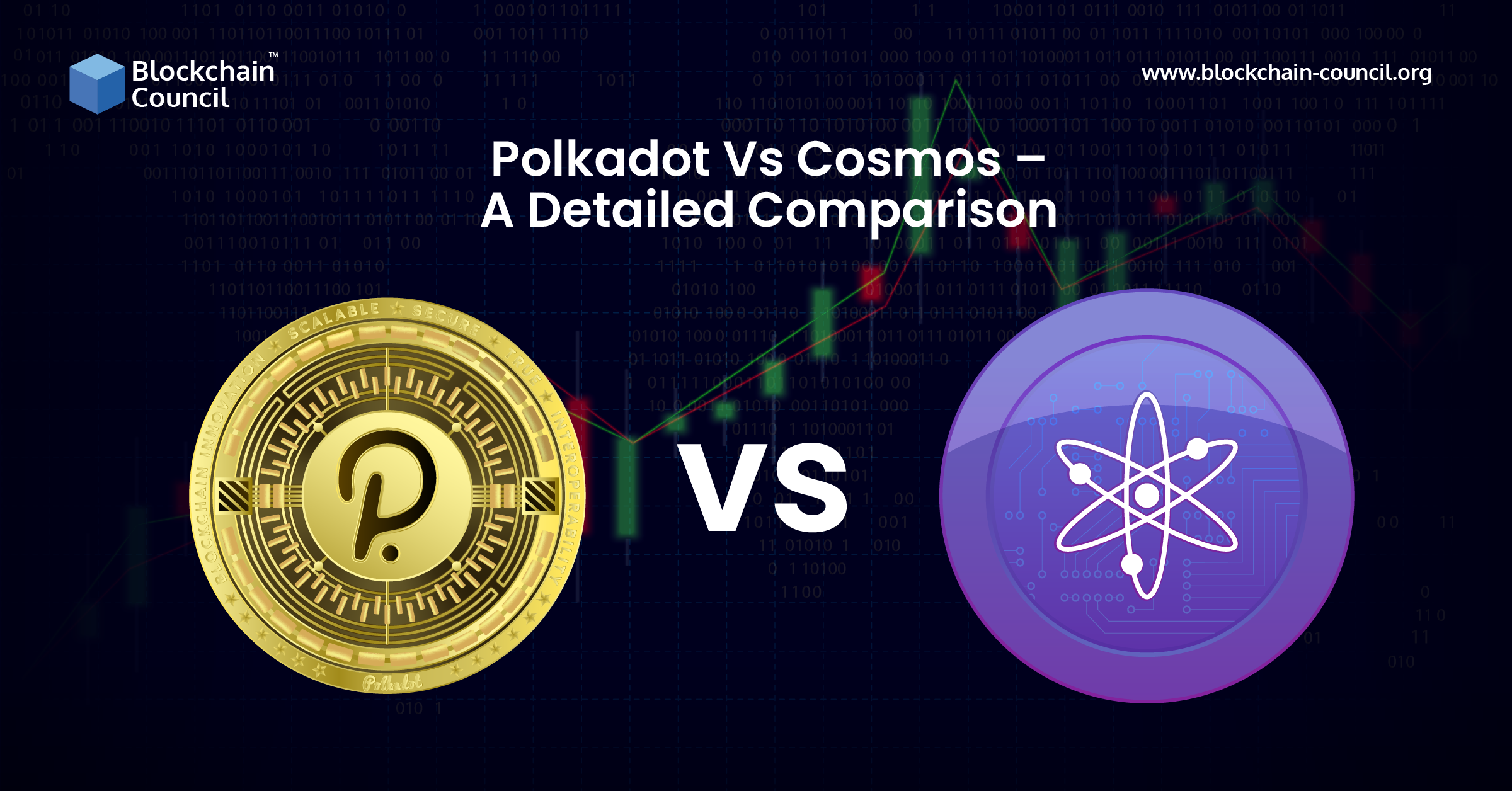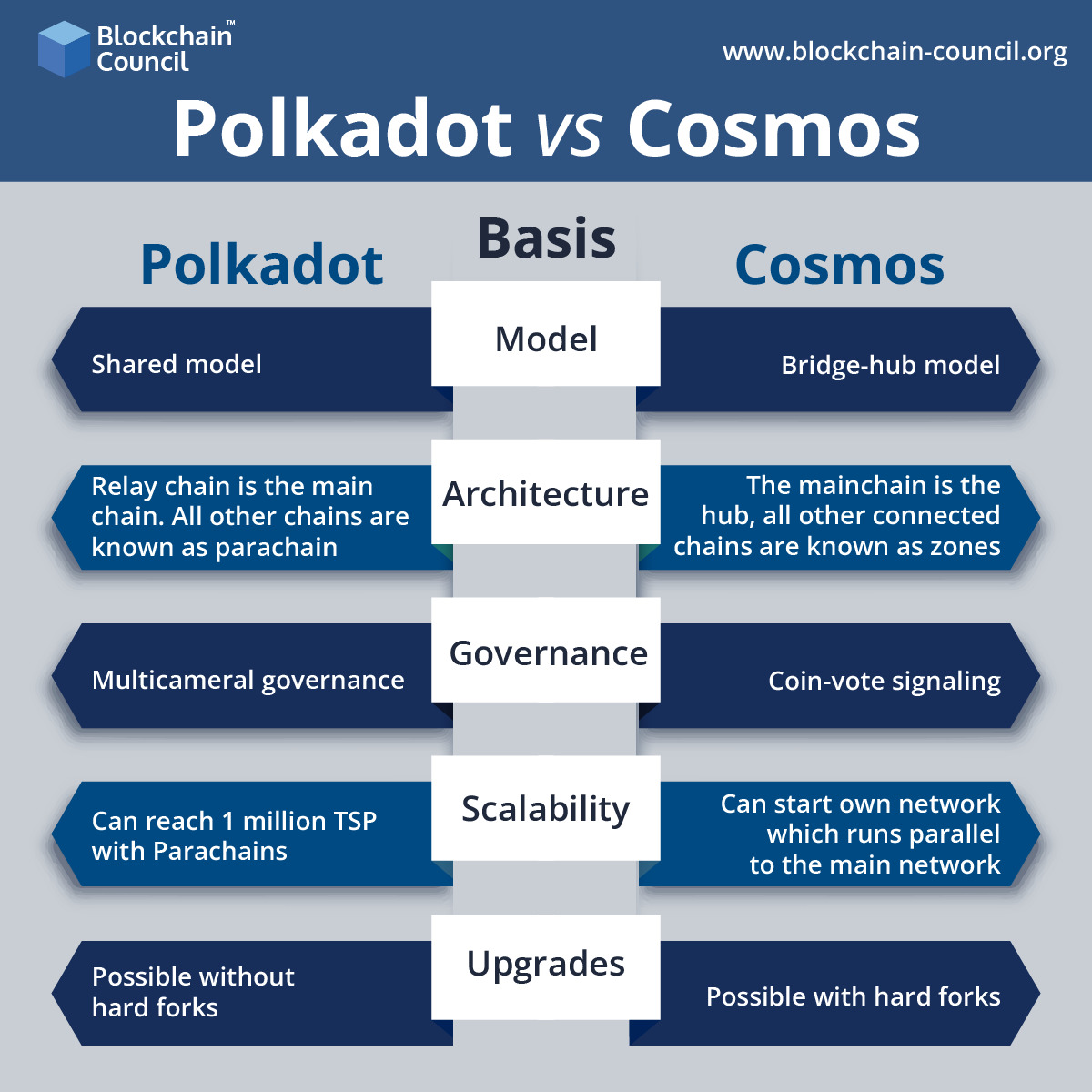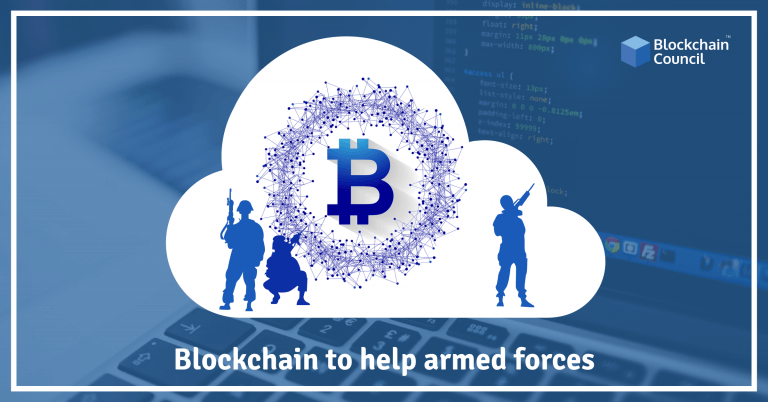
- Ayushi Abrol
- January 22, 2025
With everything from Ethereum to Bitcoin, plus countless smaller chains, it becomes challenging for developers to create applications that support multiple chains. It requires extensive resources, which is why many users only use one or two chains at a time.
Think of the blockchains as different planets of the solar system. To travel from one blockchain to the next, you need to go through an extensive long journey of exchanging the cryptos on exchanges to use different blockchains.
This process can be :
- Slow and Expensive
- Risky
- Involving Multiple Intermediaries
So, it is apparent that interoperability is one of the major issues that stop the mass adoption of blockchains. To solve this issue, Cosmos and Polkadot are two top contenders for the race of inter-chain communication. The main goal behind both Cosmos and Polkadot is to connect all of these different chains to work in tandem instead of separately.
What is Blockchain Interoperability, and How does Polkadot or Cosmos help achieve the same?
Have you ever wondered, what if your Bitcoin could be used on the Ethereum blockchain or vice versa? How about being able to use your Ethereum on an entirely different blockchain altogether? Well, it may surprise you that this is theoretically possible with something called “blockchain interoperability.”
Blockchain interoperability is the concept that blockchains can be linked to each other. This means it would be possible to send a transaction from one chain to another in the near future. For example, you might be able to transfer BTC from your Bitcoin wallet to an Ethereum wallet because the two chains are linked together.
Unfortunately, this functionality is not exactly available at the moment, but a few projects are working on making it happen. Polkadot and Cosmos are two such projects. Additionally, this will contribute significantly to scalability and decentralization in the crypto space by allowing users to interact with more than just one chain.
What is Polkadot?
Polkadot was envisioned by Dr. Gavin Wood, co-founder of Ethereum, who serves as architect and VP of Web3 Foundation. Polkadot describes itself as a Meta-Internet: an Internet of blockchains. Currently, there are many different blockchains scattered across the crypto world that fulfill different purposes.
Polkadot is creating a method for connecting and communicating between parallel blockchains on its network, called Parachains. With parachains, Polkadot solves both the issue of interoperability and scalability.
Additionally, this helps achieve optimal interoperability amongst chains, introduce independent and parallel state transitions, and provide shared security to all connected chains without sacrificing decentralization.
How does Polkadot work
The Polkadot protocol works on two consensus algorithms. These are Proof-of-Authority (PoA) and Proof-of-Stake (PoS).
In Polkadot, there will be two types of accounts:
- Normal accounts
- Controller accounts
Validators are the nodes that are used for verification on the main chain. They are responsible for ensuring the security of transactions within the network.
The Relay Chain is a core component of Polkadot’s infrastructure. It can perform validation, which means it is responsible for ensuring that the Parachains in its system are running smoothly. The Relay Chain also allows Parachains to communicate with each other, as well as with external blockchains.
Parachains are separate blockchains that run parallel to the Relay Chain, allowing them to connect to one another and share information without using a third-party service like Layer 2 scaling solutions.
The Parachains are designed so that they don’t have to compete against other networks for transaction space on their own blockchain. This makes them ideal for applications like Decentralized Exchanges (DEXs), where users need fast transaction times and low fees. Additionally, it will not clog up an already congested network like Ethereum’s.
Polkadot also has a built-in bridge chain that is responsible for connecting other blockchains that do not comply with Polkadot’s governance protocols.
What is Cosmos?
Cosmos is a network of independent blockchains—think of it as the internet of blockchains. It’s a scalable blockchain ecosystem where blockchains can interact with each other while also scaling their infrastructure to increase their user base and transaction capacity.
Along with scalability, Cosmos is trying to solve the transaction speed that cripples most blockchains. It’s similar in scope to what Polkadot is trying to do, but they have different approaches.
If you are looking for an easy way to start building your blockchain, Cosmos SDK is a great place to start. It’s beginner-friendly, and you can also build on other blockchains using Cosmos SDK, so connecting your chain with others already part of the Cosmos ecosystem is effortless.
The platform is designed to be easily transferable, allowing you to use it to build and connect your new blockchain with the Cosmos Hub while creating a network of interoperability. Cosmos aims to become a genuinely interoperable hub where transactions and data flow freely by making a more straightforward path to communication between chains.
How does Cosmos work?
Now, coming to Cosmos, which is a network of independent blockchains, each powered by BFT consensus algorithms like Tendermint Core. These can be public or private networks, including the Cosmos Hub.
There are two main parts to the Cosmos network:
- The Hub
- The Zones
The Hub is the central chain, while each Zone is a blockchain affiliated with the Hub. The Zones communicate with each other through the Cosmos Hub.
Each Zone has its own validators, which validate transactions on the Zone. The Hub runs a Proof-of-Stake (PoS) algorithm to verify transactions on the Cosmos network. The Application Blockchain Interface (ABCI) allows applications using the Tendermint core to communicate with Cosmos Hub.
This makes it easy for developers to build applications using any programming language they choose instead of writing in Solidity or another smart contract language.
And then there are Peg Zones. These chains can connect to blockchains outside of the Cosmos network, allowing for cross-chain communication between blockchains. With the Inter Blockchain Communication protocol (IBC), Peg Zones can communicate with other chains and networks connected to Cosmos Hub by linking zones and hub networks together. Any two chains attached to the Cosmos Hub can transfer tokens back and forth via IBC messages.
All of these parts work together to make sure that everything goes smoothly on the Cosmos network.
Differences between Polkadot and Cosmos
Model
Polkadot has a sharding model in which each shard has an arbitrary Strate Transition Function (STF). The STF is also available in the Web Assembly (Wasm), the meta protocol of the Polkadot ecosystem.
The shards are also known as Parachains, which are independent blockchains. When parachains submit a block, it is verified by the validators of the relay chain. Then, the transaction is passed on to the main blockchain. However, it should be noted that the state of the para chain and the main chain remains the same. That means any change in the para chain affects the whole Polkadot ecosystem.
The Cosmos network uses a bridge-hub model to connect the tendermint chains. The whole network can have multiple sets of hubs, with each hub being connected with other blockchains, referred to as Zones. Unlike Polkadot, the zones have to follow the consensus mechanism through decentralized validators.
Architecture
In the Polkadot ecosystem, the relay chain acts as the main chain, and validators function in this relay chain. In the parachain, we have the collators, and they help create new blocks, but they do not secure the transaction. This way, the Polkadot system avoids the need to pay fees to secure the network. This is the reason for the low transaction fees in the Polkadot ecosystem.
With enough funding, the projects can be chosen for parachain auctions for a period of two years. If the project does not have enough crowd loans, they can apply for parathreads. The collators in the parachain can submit a single block every 6 seconds. After that, the validators of the para chain conduct checks and then pass the transaction to the main chain. This way, the Polkadot ecosystem ensures that the main chain is not congested. Moreover, the polkadot architecture allows two-way compatibility for smooth interaction between parachains.
In the Cosmos network, the main chain is called a hub, and all other connecting blockchains are known as zones. All the zones have their respective validator communities, which increases network security capacity. Zone-to-zone communication occurs with the help of the IBC protocol and finality algorithms like Tendermint.
The hub is responsible for keeping track of the multi-token ledger. At the same time, the zones are responsible for monitoring the hub with its validators. However, the hub does not have the capability to track the zones.
Governance
In the Polkadot ecosystem, we have multicameral governance. A proposal has to pass through multiple houses before it becomes a rule. At present, there can be 100 parachains in its network. The parachains are selected based on auctions. A project can secure its position as a para chain based on the DOT token it has staked in the Polkadot network. The number of votes is also determined by the number of DOT tokens. In case of low turnouts in the voting referenda, the polka dot has to use a biased algorithm to make decisions on fund allocation and fees.
On the other hand, Cosmos has a more relaxed set of rules and uses coin-votes to pass referenda. Any blockchain can become a hub of Cosmos. Moreover, it does not have a centralized governance system, and each hub is governed by its own set of rules.
Scalability
Out of the two, Polkadot has robust scalability options. The parachains of the Polkadot are full-fledged blockchains on their own, and they run parallel with the main chain. Parachains are dependent on the polka-dot main chain for consensus. They can communicate with each other with the help of cross-chain message passing (XCMP).
The parachains are dependent on the polkadot ecosystem. However, the polka dot main chain is independent of its own consensus mechanism. However, it should be noted that to reach a transaction speed of 1 million transactions per second, the main chain needs to depend on the parachains. Moreover, the polka dot is made with the substrate, a blockchain framework that can run blockchains autonomously.
On the other hand, Cosmos allows developers to start their own blockchain from scratch. It also provides a consensus mechanism, network infrastructure, and application layers to form a blockchain. This is done by using SDK, where developers can start their own network, which can run parallel to the main network. This solves the congestion problem and also makes the whole Cosmos network secure.
Upgrades
Another issue with blockchains is the lack of upgrades. Upgrades like debugging the system need the consensus of the majority token holders. This takes time and leaves the whole network vulnerable. The entire network needs to be transferred to an upgraded blockchain with proposed upgrades. This process is called a hard fork. This consumes time and resources.
The polkadot ecosystem has been made with flexible upgradability options in mind. Every part of the main chain, the STF, off-chain validators, and transaction queue can be upgraded without hard forking the main chain.
On the other hand, Cosmos does not have a meta protocol and needs to deploy upgrades using the hard forking of the main chain.
Conclusion
According to Metcalfe’s law, the value of a telecommunication network is the square of the total number of users. This essentially means that if all the scattered blockchain networks can talk with each other, their shared value will be billions. A shared blockchain space will bring the best of all the blockchains in a shared space and revolutionize the blockchain industry.
Though both the projects aim to solve the problem of interoperability. At present, Polkadot is more valuable than Cosmos, and both projects have a lot of differences between them. So, it is important to see which project can first solve the issue of interoperability and open up the space for mass adoption of cryptocurrency.






































































 Guides
Guides News
News Blockchain
Blockchain Cryptocurrency
& Digital Assets
Cryptocurrency
& Digital Assets Web3
Web3 Metaverse & NFTs
Metaverse & NFTs
